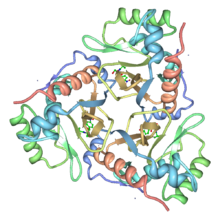Chloramphenicol acetyltransferase
| Chloramphenicol acetyltransferase | |||||||||
|---|---|---|---|---|---|---|---|---|---|

|
|||||||||
| Identifiers | |||||||||
| Symbol | CAT | ||||||||
| Pfam | PF00302 | ||||||||
| InterPro | IPR001707 | ||||||||
| PROSITE | PDOC00093 | ||||||||
| SCOP | 3cla | ||||||||
| SUPERFAMILY | 3cla | ||||||||
|
|||||||||
| Available protein structures: | |
|---|---|
| Pfam | structures |
| PDB | RCSB PDB; PDBe; PDBj |
| PDBsum | structure summary |
| Chloramphenicol acetyltransferase | |||||||||
|---|---|---|---|---|---|---|---|---|---|
| Identifiers | |||||||||
| EC number | 2.3.1.28 | ||||||||
| CAS number | 9040-07-7 | ||||||||
| Databases | |||||||||
| IntEnz | IntEnz view | ||||||||
| BRENDA | BRENDA entry | ||||||||
| ExPASy | NiceZyme view | ||||||||
| KEGG | KEGG entry | ||||||||
| MetaCyc | metabolic pathway | ||||||||
| PRIAM | profile | ||||||||
| PDB structures | RCSB PDB PDBe PDBsum | ||||||||
| Gene Ontology | AmiGO / EGO | ||||||||
|
|||||||||
| Search | |
|---|---|
| PMC | articles |
| PubMed | articles |
| NCBI | proteins |
Chloramphenicol acetyltransferase (or CAT) is a bacterial enzyme (EC 2.3.1.28) that detoxifies the antibiotic chloramphenicol and is responsible for chloramphenicol resistance in bacteria. This enzyme covalently attaches an acetyl group from acetyl-CoA to chloramphenicol, which prevents chloramphenicol from binding to ribosomes. A histidine residue, located in the C-terminal section of the enzyme, plays a central role in its catalytic mechanism.
The crystal structure of the type III enzyme from Escherichia coli with chloramphenicol bound has been determined. CAT is a trimer of identical subunits (monomer Mr 25,000) and the trimeric structure is stabilised by a number of hydrogen bonds, some of which result in the extension of a beta-sheet across the subunit interface. Chloramphenicol binds in a deep pocket located at the boundary between adjacent subunits of the trimer, such that the majority of residues forming the binding pocket belong to one subunit while the catalytically essential histidine belongs to the adjacent subunit. His195 is appropriately positioned to act as a general base catalyst in the reaction, and the required tautomeric stabilisation is provided by an unusual interaction with a main-chain carbonyl oxygen.
CAT is used as a reporter system to measure the level of a promoter or its tissue-specific expression. The CAT assay involves monitoring acetylation of radioactively labeled chloramphenicol on a TLC plate; CAT activity is determined by looking for the acetylated forms of chloramphenicol, which have a significantly increased migration rate as compared to the unacetylated form.
This article incorporates text from the public domain Pfam and InterPro IPR001707
...
Wikipedia
